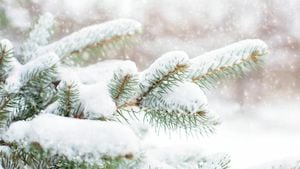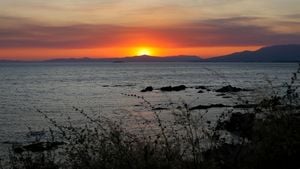On the shores of Newfoundland, a peculiar phenomenon captured the collective curiosity of locals and scientists alike: mysterious white blobs washing ashore. These gobs, initially the subject of wild speculation, have been identified as plastic pollution, much to the relief and chagrin of environmentalists.
The unsettling discovery first made headlines when residents of Placentia Bay began encountering the sponge-like substances on their beaches. Early September yielded numerous reports of these blobs, which sparked various hypotheses among the public. Was it waste discharge from boats? Could it be some form of strange biological organism? Or, as some unkindly joked, were they whale excrement?
According to Christopher Kozak, a chemistry professor at Memorial University, the truth is much simpler yet still worrying. He confirmed the blobs are made of polyvinyl acetate, commonly found in adhesives. “It's man-made. It’s not natural,” he stated during an interview with CBC Radio's The Broadcast. This chemical analysis, he explained, was based on testing for elements like nitrogen and sulfur, which were absent, leading him to pinpoint the blobs’ composition.
“I think what I’ve nailed it down to is polyvinyl acetate,” Kozak declared. His findings indicate the blobs might be byproducts of industrial activities, possibly related to glue manufacturing. Ranging from adhesives to thin films, PVA is ubiquitous with many applications, particularly emphasizing its role as industrial adhesives rather than everyday school supplies.
The inquiry began with fellow researcher Hilary Corlett, who also works at Memorial University. Captivated by the peculiar blobs, Corlett initially collected samples from Arnold’s Cove after observing their odd features, including the pebbles embedded within some specimens. Her instinct pointed toward something fabricated rather than organic, so she enlisted Kozak’s expertise to run detailed analyses.
Kozak and his team undertook what they dubbed “Project Unknown Glob,” conducting tests for hydrogen, oxygen, and other chemical properties. They even assessed combustibility to identify how the blobs might react under heat. Interestingly, he noted, "This is not some school kids' science experiment that's gone awry — but it's a similar sort of thing.”
Despite their concerning origins, Kozak reassured the public about the safety of handling these blobs. “I definitely wouldn’t eat it, but I’ve been able to handle it. It’s fine,” he said, adding, “It still has a bit of a volatile odor to it.” While stable enough for human contact, he recommended against using them as sponges or any other purpose beyond disposal.
The non-edibility of the blobs doesn't mask their risks. Kozak warned about potential threats to local wildlife, particularly animals mistaking the blobs for jellyfish, which could result in harmful ingestion. Hence, he urged anyone who encounters these substances to dispose of them responsibly by tossing them out or notifying wildlife authorities.
Residents living near Placentia Bay have expressed genuine concern over these blobs, with Corlett stating her commitment to provide clarity around their origin. "It's important we try and use the tools we have at Memorial to figure this out for them, because it must be disturbing," she noted, emphasizing the unusualness of such findings on their familiar shores.
Now, with confirmation of the blobs’ polymer makeup, the pressing question remains: Where are they coming from? Kozak suggests collaborative research with the Department of Fisheries and Oceans (DFO) could yield insights, especially focusing on large industrial adhesive use within the area. While there aren’t definitive answers yet, Kozak is mindful of responsibility—he plans to communicate his findings to relevant governmental bodies, hoping to contribute to broader investigations.
This blob discovery isn't unique to Newfoundland beaches; similar instances of plastic pollution have made headlines worldwide, highlighting the pervasive issue of plastic waste and its undeniable impact on marine and coastal environments. Unfortunately, many regions are still grappling with how to address the growing tide of plastic debris.
Plastic pollution takes various forms, but one common aspect is its origin — frequently tied to consumer habits and industrial processes. Awareness and action remain at the forefront of combating this environmental challenge, as seen through community-led cleanups and increased dialogues about responsible consumption.
The Newfoundland situation serves as both a wake-up call and a vivid illustration of how interconnected our ecological footprints are. Preventing such scenarios requires collective efforts spanning local public interest to wider governmental policies. It’s not just plastic — it’s about ensuring sustainable practices to safeguard natural beauty for generations to come.
So, as researchers and teams like Cox and Corlett persist with their investigations, the residents of Newfoundland stand vigilant, aware of the unique challenges their pristine beaches face due to human activity. Together, they hope to untangle the mystery not just of these blobs but of the overarching issue of pollution lurking beneath the surface.



